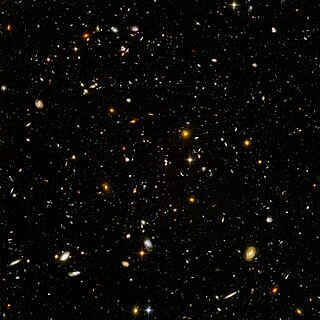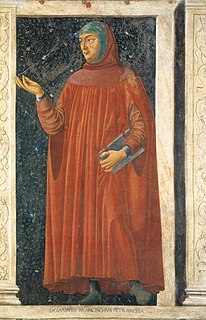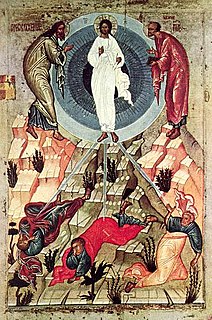Related Research Articles

The universe is all of space and time and their contents, including planets, stars, galaxies, and all other forms of matter and energy. The Big Bang theory is the prevailing cosmological description of the development of the universe. According to this theory, space and time emerged together 13.787±0.020 billion years ago, and the universe has been expanding ever since the Big Bang. While the spatial size of the entire universe is unknown, it is possible to measure the size of the observable universe, which is approximately 93 billion light-years in diameter at the present day.

The drow or dark elves are a dark-skinned and white-haired subrace of elves connected to the subterranean Underdark in the Dungeons & Dragons fantasy roleplaying game. The drow have traditionally been portrayed as generally evil and connected to the evil goddess Lolth. However, later editions of Dungeons & Dragons have moved away from this portrayal and preassigned alignment. More recent publications have explored drow societies unconnected to Lolth.

The "Dark Ages" is a term for the Early Middle Ages, or occasionally the entire Middle Ages, in Western Europe after the fall of the Western Roman Empire that characterises it as marked by economic, intellectual and cultural decline.
Gothic rock is a style of rock music that emerged from post-punk in the United Kingdom in the late 1970s. The first post-punk bands which shifted toward dark music with gothic overtones include Siouxsie and the Banshees, Joy Division, Bauhaus, and the Cure.

Darkness, the direct opposite of lightness, is defined as a lack of illumination, an absence of visible light, or a surface that absorbs light, such as black or brown.
Dark wave is a music genre that emerged from the new wave and post-punk movement of the late 1970s. Dark wave compositions are largely based on minor key tonality and introspective lyrics and have been perceived as being dark, romantic and bleak, with an undertone of sorrow. The genre embraces a range of styles including cold wave, ethereal wave, gothic rock, neoclassical dark wave and neofolk.

The Dark Tower is a series of eight novels and one short story written by American author Stephen King. Incorporating themes from multiple genres, including dark fantasy, science fantasy, horror, and Western, it describes a "gunslinger" and his quest toward a tower, the nature of which is both physical and metaphorical. The series, and its use of the Dark Tower, expands upon Stephen King's multiverse and in doing so, links together many of his other novels.
A dark net or darknet is an overlay network within the Internet that can only be accessed with specific software, configurations, or authorization, and often uses a unique customized communication protocol. Two typical darknet types are social networks, and anonymity proxy networks such as Tor via an anonymized series of connections.

Dark fantasy is a subgenre of fantasy literary, artistic, and cinematic works that incorporate disturbing and frightening themes of fantasy. It often combines fantasy with elements of horror or has a gloomy dark tone or a sense of horror and dread.

Dark Night of the Soul is a poem written by the 16th-century Spanish mystic and poet St. John of the Cross. The author himself did not give any title to his poem, on which he wrote two book-length commentaries: Ascent of Mount Carmel and The Dark Night.
In many languages, the colors described in English as "blue" and "green" are colexified, i.e. expressed using a single cover term. To describe this English lexical gap, linguists use the portmanteau word grue, from green and blue, a term coined by the philosopher Nelson Goodman—with a rather different meaning—in his 1955 Fact, Fiction, and Forecast to illustrate his "new riddle of induction". The alternative, bleen, is not really used.
Dark cabaret may be a simple description of the theme and mood of a cabaret performance, but more recently has come to define a particular musical genre which draws on the aesthetics of the decadent, risqué German Weimar-era cabarets, burlesque and vaudeville shows with the stylings of post-1970s goth and punk music.

Chestnut is a hair coat color of horses consisting of a reddish-to-brown coat with a mane and tail the same or lighter in color than the coat. Chestnut is characterized by the absolute absence of true black hairs. It is one of the most common horse coat colors, seen in almost every breed of horse.

The Dark Knight is a 2008 superhero film directed by Christopher Nolan from a screenplay he co-wrote with his brother Jonathan. Based on the DC Comics superhero Batman, it is the sequel to Batman Begins (2005) and the second installment in The Dark Knight Trilogy. The film follows the vigilante Batman, police lieutenant James Gordon, and district attorney Harvey Dent as they form an alliance to dismantle organized crime in Gotham City. Their efforts are derailed by the intervention of the Joker, an anarchistic mastermind who seeks to test how far Batman will go to save the city from complete chaos. The ensemble cast includes Christian Bale, Michael Caine, Heath Ledger, Gary Oldman, Aaron Eckhart, Maggie Gyllenhaal, and Morgan Freeman.

Horses exhibit a diverse array of coat colors and distinctive markings. A specialized vocabulary has evolved to describe them.
Certain music is sometimes described as "dark" in a metaphorical sense. For example, "dark pop" is often indiscriminately applied to a wide range of disparate artists, but usually refers to pop music that incorporates synthesizers or a minor key. In Germany, the term schwarze Szene has been "used since the 1990s to describe all the so called dark alternative music styles swirling around Goth: industrial, darkwave, electro, metal, neofolk and medieval, including BDSM/fetish culture".

Markings on horses are usually distinctive white areas on an otherwise dark base coat color. Most horses have some markings, and they help to identify the horse as a unique individual. Markings are present at birth and do not change over the course of the horse's life. Most markings have pink skin underneath most of the white hairs, though a few faint markings may occasionally have white hair with no underlying pink skin. Markings may appear to change slightly when a horse grows or sheds its winter coat, however this difference is simply a factor of hair coat length; the underlying pattern does not change.
Nick Land is an English philosopher, theorist, short story writer and blogger. He has been described as "the father of accelerationism", and was a leader of the 1990s collective Cybernetic Culture Research Unit after its original founder cyberfeminist theorist Sadie Plant departed from it. His work has since been tied to the development of accelerationism and speculative realism. His writing, beginning to take shape in the 1990s, has been described as "theory-fiction", departing from the formal conventions of academic writing and embracing a wide range of influences, as well as exploring unorthodox and "dark" philosophical interests.

In Norse mythology, Dökkálfar and Ljósálfar are two contrasting types of elves; the dark elves dwell within the earth and have a dark complexion, while the light elves live in Álfheimr, and are "fairer than the sun to look at". The Ljósálfar and the Dökkálfar are attested in the Prose Edda, written in the 13th century by Snorri Sturluson, and in the late Old Norse poem Hrafnagaldr Óðins. Scholars have produced theories about the origin and implications of the dualistic concept.
The Dark Enlightenment, also called neo-reactionary movement, is an anti-democratic, anti-egalitarian, reactionary philosophy. In 2007 and 2008, Curtis Yarvin, writing under the pen name Mencius Moldbug, articulated what would develop into Dark Enlightenment thinking. Yarvin's theories were elaborated and expanded by Nick Land, who first coined the term Dark Enlightenment in his essay of the same name. The term "Dark Enlightenment" is a reaction to the Age of Enlightenment.
References
- ↑ "GlobIZ search". Global Information System on Pyraloidea. Retrieved September 14, 2017.
- ↑ Bulletin - United States National Museum
 This article incorporates text from this source, which is in the public domain .
This article incorporates text from this source, which is in the public domain .